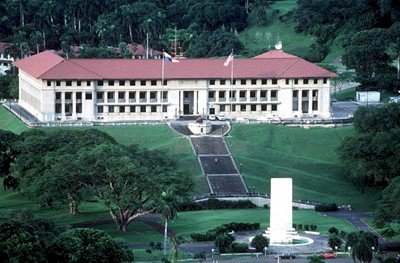IMPACT OF
THE PANAMA CANAL TREATIES ON THE PANAMA CANAL (continued)
INITIAL TREATY
IMPLEMENTATION
The Protocol of Exchange of
Instruments of Ratification of the two treaties was signed in
Panama City, Panama, on June 16, 1978, by President Carter and
General Torrijos, during President Carter's two-day visit to
Panama City. The instruments of ratification had established
October 1, 1979, as the date when the treaties became legally
binding. The legislation required to implement the treaties (the
Panama Canal Act of 1979) was approved by the U.S. Congress
virtually on the eve of treaty implementation. The treaties
entered into force October 1, 1979.
On that date, the Canal Zone and
the Canal Zone Government were dissolved (with about 65 percent of
the Canal Zone transferred to Panama), and the Panama Canal
Company was replaced by a bi-national Panama Canal Commission,
with a board of directors consisting of five Americans and four
Panamanians. Since October 1, 1979, U.S. military presence in the
former Canal Zone had been governed by governed by a Status of
Forces Agreement (SOFA) similar to those which the United States
has with governments in other parts of the world. The SOFA was the
Agreement in Implementation of Article IV of the Panama Canal
Treaty, which accompanied the Panama Canal Treaty.
TREATY PROVISIONS
Canal
Operation
The United States was
responsible for operation of the canal until noon December 31,
1999. It continued to have access to and the right to use land and
water areas and facilities necessary for the operation and
maintenance of the canal during the Treaty period (through 1999).
 |
|
Panama Canal
Administration
Building
at
Balboa
Heights
, headquarters of the
Panama Canal
organization since 1914.
Goethals
Monument
is in the center. Both countries' flags
were flown at the building since
October 1, 1979
through
December 31, 1999
. (Photo
courtesy of the
Panama Canal
Commission/Panama Canal Authority
|
The Panama Canal Commission (a U.S.
Government agency, as designated by Article III of the Panama
Canal Treaty and by the U.S. implementing legislation of 1979)
managed, operated, and maintained the canal. The authority of the
President of the United States with respect to the Panama Canal
was exercised through the Secretary of Defense and the Secretary
of the Army, as was the practice with the Commission's predecessor
agency, the Panama Canal Company. In February 1996, the Commission
was converted to a wholly owned U.S. Government corporation under
Public Law 104-106 (Defense Authorization Act for fiscal year
1996). This Act opened the way for changes to be made to other
laws that allow the agency to operate in a more businesslike
fashion and better meet transition needs, according to Commission
officials.
Five American and four Panamanians
constituted the Commission's Supervisory Board (Board of
Directors), with one of the U.S. members being the Board's
chairman. Panamanian board members were proposed by Panama and
appointed by the U.S. President. During the first part of the
treaty transition period, the Chairman was the Assistant Secretary
of the Army for Civil Works, but later the position was filled by
either the Under Secretary or Secretary of the Army. Chairmen of
the Board during the life of the Panama Canal Commission were:
Michael Blumenfeld, William R. Gianelli, Robert W. Page, Michael
P.W. Stone, John W. Shannon, Joe R. Reeder, Togo West, and Louis
Caldera. (Stone, Shannon, and West were Secretaries of the Army,
as was Caldera; Reeder was Under Secretary of the Army.)